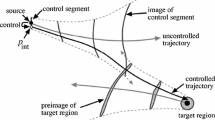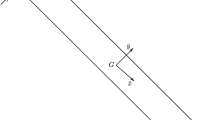Abstract
The two-body problem is a twelfth-order time-invariant dynamic system, and therefore has eleven mutually-independent time-independent integrals, here referred to as motion constants. Some of these motion constants are related to the ten mutually-independent algebraic integrals of the n-body problem, whereas some are particular to the two-body problem. The problem can be decomposed into mass-center and relative-motion subsystems, each being sixth-order and each having five mutually-independent motion constants. This paper presents solutions for the eleventh motion constant, which relates the behavior of the two subsystems. The complete set of mutually-independent motion constants describes the shape of the state-space trajectories. The use of the eleventh motion constant is demonstrated in computing a solution to a two-point boundary-value problem.
Similar content being viewed by others
References
Battin R.H.: An Introduction to the Mathematics and Methods of Astrodynamics, Revised Edition, sect. 2.4 & 3.6 and chap. 4. AIAA, Virginia (1999)
Bruns H.: Über die integrale des Vielkörper-problems. Acta Mathematica 11, 25–96 (1887)
Gronchi G.F., Dimare L., Milani A.: Orbit determination with the two-body integrals. Celest. Mech. Dyn. Astron. 107, 299–318 (2010)
Herrick S.: Universal variables. Astron. J. 70, 309–315 (1965)
Isidori A.: Nonlinear Control Systems, 2 edn. sect. 1.4. Springer, Berlin (1989)
Poincaré H.: Sur la méthode de Bruns. Comptes rendus hebdomadaires des séances de l’Académie des sciences 123, 1224–1228 (1896)
Poincaré H.: Sur une forme nouvelle des équations de la mécanique. C.R. Acad. Sci. 132, 369–371 (1901)
Prussing J.E., Conway B.A.: Orbital Mechanics, sect. 1.2. Oxford University Press, New York, NY (1993)
Roy A.E.: Orbital Motion, 4 edn. sect. 5.3. Taylor & Francis, New York (2005)
Schaub H., Junkins J.L.: Analytical Mechanics of Space Systems, pp. 558. AIAA, Virgina (2003)
Stumpff K.: Neue Formeln und Hilfstafeln zur Ephemeridenrechnung. Astron. Nachrichten 275, 108–128 (1947)
Szebehely V.: Theory of Orbits, sect. 1.3, 1.8 & 2.1. Academic Press, New York (1967)
Vallado D.A.: Fundamentals of Astrodynamics and Applications, 2 edn. sect. 1.4.2. Microcosm Press, El Segundo, California (2001)
Whittaker E.T.: A Treatise on the Analytical Dynamics of Particles and Rigid Bodies, 4 edn. sect. 37 & 155 and chap. 14. Cambridge University Press, Cambridge, UK (1970)
Author information
Authors and Affiliations
Corresponding author
Rights and permissions
About this article
Cite this article
Sinclair, A.J., Hurtado, J.E. The eleventh motion constant of the two-body problem. Celest Mech Dyn Astr 110, 189–198 (2011). https://doi.org/10.1007/s10569-011-9350-6
Received:
Revised:
Accepted:
Published:
Issue Date:
DOI: https://doi.org/10.1007/s10569-011-9350-6




